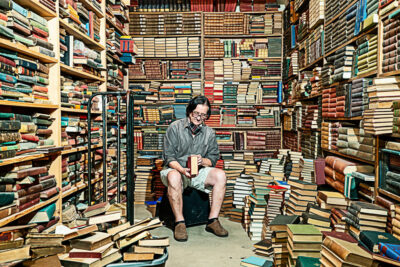Washington’s Secret to the Perfect Zoom Bookshelf? Buy It Wholesale.

From POLITICO.COM – POLITICO MAGAZINE
By ASHLEY FETTERS
12/26/2020 06:30 AM EST
Ashley Fetters is a feature reporter at the Washington Post.
In a place like Washington—small, interconnected, erudite, gossipy—being well-read can create certain advantages. So, too, can seeming well-read. The “Washington bookshelf” is almost a phenomenon in itself, whether in a hotel library, at a think tank office or on the walls behind the cocktail bar at a Georgetown house.
And, as with nearly any other demand of busy people and organizations, it can be conjured up wholesale, for a fee.
Books by the Foot, a service run by the Maryland-based bookseller Wonder Book, has become a go-to curator of Washington bookshelves, offering precisely what its name sounds like it does. As retro as a shelf of books might seem in an era of flat-panel screens, Books by the Foot has thrived through Democratic and Republican administrations, including that of the book-averse Donald Trump. And this year, the company has seen a twist: When the coronavirus pandemic arrived, Books by the Foot had to adapt to a downturn in office- and hotel-decor business—and an uptick in home-office Zoom backdrops for the talking-head class.
The Wonder Book staff doesn’t pry too much into which objective a particular client is after. If an order were to come in for, say, 12 feet of books about politics, specifically with a progressive or liberal tilt—as one did in August—Wonder Book’s manager, Jessica Bowman, would simply send one of her more politics-savvy staffers to the enormous box labeled “Politically Incorrect” (the name of Books by the Foot’s politics package) to select about 120 books by authors like Hillary Clinton, Bill Maher, Al Franken and Bob Woodward. The books would then be “staged,” or arranged with the same care a florist might extend to a bouquet of flowers, on a library cart; double-checked by a second staffer; and then shipped off to the residence or commercial space where they would eventually be shelved and displayed (or shelved and taken down to read).
Only sometimes do Bowman and Wonder Book President Chuck Roberts know the real identity of the person whose home or project they’ve outfitted: “When we work with certain designers, I pretty much already know it’s going to be either an A-list movie or an A-list client. They always order under some code name,” Bowman says. “They’re very secretive.”
Roberts opened the first of Wonder Book’s three locations in 1980, but Books by the Foot began with the dawn of the internet in the late 1990s. A lover of books who professes to never want to see them destroyed, he described the service as a way to make lemonade out of lemons; in this case, the lemons are used books, overstock books from publishers or booksellers, and other books that have become either too common or too obscure to be appealing to readers or collectors. “Pretty much every book you see on Books by the Foot [is a book] whose only other option would be oblivion,” Roberts says.
Located in Frederick, Wonder Book’s 3-acre warehouse full of 4 million books is a short jaunt from the nation‘s capital. While the company ships nationally, it gets a hefty portion of its business from major cities including Washington. And, over the past two decades, Books by the Foot’s books-as-decor designs have become a fixture in the world of American politics, filling local appetite for books as status symbols, objects with the power to silently confer taste, intellect, sophistication or ideology upon the places they’re displayed or the people who own them.
Wonder Book’s designs have been featured in a number of locations in and around D.C. According to Roberts, The Madison hotel once purchased 19th-century American history texts to use in its decor, and the Washington Hilton ordered books by color a while back (“Earth Tones,” he recalled) to place in some of its suites. (General managers at both hotels said they were unfamiliar with the orders, which Roberts said were placed a number of years ago.) Meanwhile, shows at the Kennedy Center have used Books by the Foot’s curations onstage, and sometimes the company’s handiwork even shows up in the homes of politicians.
“We see a lot of them,” Bowman says. “You’ll see in the news they’ll have Books by the Foot [books] in their images in the newspapers, [alongside stories] going inside politicians’ homes and things like that.”
In 2010, NBC’s “Meet the Press” came calling. The show was switching to high definition and debuting a new set with well-stocked bookshelves to commemorate the occasion. Clickspring Design, the firm that designed the set, ordered books on politics, law and an assortment in the style of Books by the Foot’s “Professional Glossy Look.” Bowman remembers the order was for somewhere around 200 feet, or roughly the length of three semitrucks.
Erik Ulfers, founder and president of Clickspring, noted that a good TV set either transports viewers to someplace completely new and unfamiliar (“some are very abstract, really graphic-heavy”) or invites them to someplace welcoming and relatable. He recalls that he wanted the books on the “Meet the Press“ set to project familiarity infused with a sort of intellectual gravitas. He requested vintage books, he says—“It suggests a longer history, and somehow it seems more academic”—and replaced the pages in a number of the books with Styrofoam to avoid overloading the shelves. (When asked about this, Roberts wrote in an email, “As long as books are put in the public eye—and private eyes—they are still part of the culture.” “Meet the Press“ didn’t respond to a request for comment about the order.)
Books by the Foot’s creations have also popped up in a variety of TV shows and movies, many of them politics-adjacent. “Madam Secretary,” “Veep,” “The Blacklist,” “House of Cards,” as well as the 2017 movie Chappaquiddick, for example, have all outfitted their sets with Books by the Foot curations. Some of the most high-profile projects the team works on, however, aren’t revealed to them until after the fact: Bowman has had the distinctly surreal experience of watching a movie for the first time and recognizing her work onscreen. (That’s how it works, she said, with “pretty much anything Marvel.”)
Although TV shows set in Washington underwent a change in tone when Trump was elected (as did much of Washington itself), D.C. residents’ appetites for well-stocked bookshelves, whether as functional libraries or as vanity props, seems to have survived. Or at least, that’s what the demand for Books by the Foot’s services would indicate: The orders Roberts and his staff handled in the Trump years weren’t all that different from the orders they fielded in prior administrations.
To Roberts, though, the unchanging demand is a good thing. One of the positives for a business like his, he wrote in an email, is that familiar types of people, who work in similar fields and likely share similar aspirations, are constantly moving in and out of the area: “Military, [employees of the] State Department and embassies, political folks” are always either settling in or leaving. The imminent changeover to the Biden administration will likely bring precisely the type of new business Books by the Foot has depended on for years.
In 2020, of course, everything changed for Books by the Foot around the same time everything changed for everyone else. For most of the year, the coronavirus pandemic switched up the proportion of Books by the Foot’s commercial to residential projects: In July, Roberts said residential orders, which had previously accounted for 20 percent of business, now accounted for 40 percent. That was partly due to the closures of offices and hotels, Roberts noted—but a few other things were afoot, too.
For one, more people were ordering books with the apparent intent to read them. “We’re seeing an uptick in books by subject, which are usually for personal use,” Roberts said over the summer. Because many people suddenly had extra time at home but hardly anyone was able to shop in brick-and-mortar stores, orders for, say, 10 feet of mysteries, or 3 feet of art books, rose in popularity.
Another force at work, however, was the rise of the well-stocked shelf as a coveted home-office prop. When workplaces went remote and suddenly Zoom allowed co-workers new glimpses into one another’s homes, what New York Times writer Amanda Hess dubbed the “credibility bookcase” became the hot-ticket item. (“For a certain class of people, the home must function not only as a pandemic hunkering nest but also be optimized for presentation to the outside world,” she wrote.) And while Roberts makes an effort not to infer too much about his clients or ask too many questions about their intent, he did notice a very telling micro-trend in orders he was getting from all across the United States.
“We can sort of, you know, guess, or read between the lines, and we’ve had an uptick in smaller quantities,” Roberts said over the summer. “If your typical bookcase is 3 feet wide, and you just want to have the background from your shoulders up, then you might order 9 feet of history, or 9 feet of literature. That way, you put them on your home set … [and] nobody can zoom in on these books and say, Oh my God, he’s reading … you know, something offensive, or tacky. Nothing embarrassing.”
In the fall, Roberts said, numbers evened out somewhat, thanks to some commercial spaces reopening. But Books by the Foot might be taking on a higher percentage of home-library projects well into the future.
Jill Mastrostefano is the creative director and lead designer at PFour, an interior design firm that does, by her estimate, about 75 percent of its business in D.C., Maryland and Virginia. Historically, Mastrostefano mostly has ordered books by color from Books by the Foot, usually to create pops of brightness or accent points in show houses (homes built to display the designs available in a particular subdivision). But this year, she has spent a good chunk of her time outfitting model homes with specific rooms where people can envision themselves taking all their work Zoom meetings.
“We are probably going to be ordering more books because of what are now called ‘Zoom rooms,’ instead of studies,” she says. “People need to, you know, look good when [they’re] on video.”
In Washington and in political circles all over the United States, the fact that people are still, after more than nine months, showing up to work meetings and doing live TV appearances from inside their own homes likely means there will be sustained demand for impressive-looking bookshelves. And given that much of the politics-adjacent workforce won’t go back to working in offices until next summer, Books by the Foot can likely count on consistent Zoom-room business until then.
Of course, there’s evidence to suggest that people want to be or appear well-read but keep Books by the Foot’s involvement hidden. People probably don’t want to talk about their credibility shelves, Roberts points out.
Which has always been, and remains, perfectly fine with him and perfectly fine with Bowman. After assembly in the Wonder Book warehouse, that 12-foot order of left-leaning politics books from August (a somewhat large order for a residential project) was shipped to a private residence in New York for a client whose identity was unknown to Bowman—someone whose use for the books might be revealed one day, or might stay hidden from public view for

